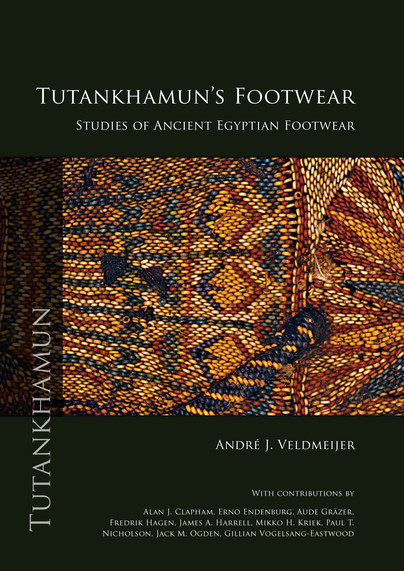
Format: Hardback
Pages: 312
ISBN: 9789088904745
Pub Date: 15 Dec 2017
Imprint: Sidestone Press
Illustrations: 286fc/105bw
Description:
The discovery of Tutankhamun’s tomb by Howard Carter in 1922 is one of the most significant archaeological discoveries of all time. It took Carter and his team 10 years to clear the contents of the tomb and among the objects found was a large collection of shoes and sandals. The footwear is analysed here in detail for the first time since the discovery using Carter’s records and Harry Burton’s excellent photographs along with the author’s analyses of the objects, all of which are housed in the Egyptian Museum, Cairo and the Luxor Museum.
Several specialists contributed to the volume discussing the different materials (gold, vegetable fibre, birch bark, glass and faience, leather, gemstones) that were used in the footwear. Tutankhamun’s footwear is compared with other finds in order to be able to put it in a broader context. The footwear from the tomb of Yuya and Tjuiu, the King’s great-grandparents, are, therefore, analysed as well. In addition to the analysis, footwear in texts and two- and three-dimensional art is considered.With contributions byAlan J. Clapham, Erno Endenburg, Aude Gräzer, Fredrik Hagen, James A. Harrell, Mikko H. Kriek, Paul T. Nicholson, Jack M. Ogden, Gillian Vogelsang-Eastwood
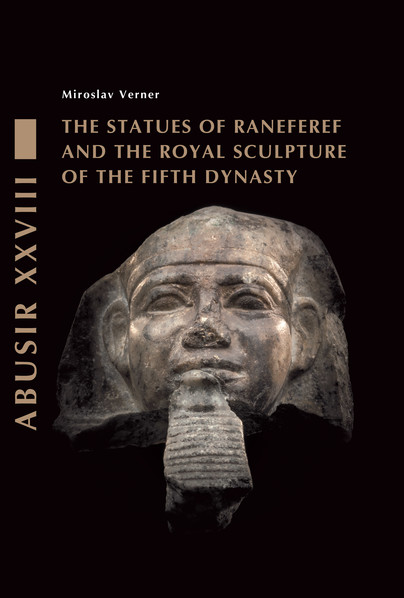
Format: Hardback
Pages: 259
ISBN: 9788073087456
Pub Date: 12 Dec 2017
Imprint: Czech Institute of Egyptology
Series: Abusir Monographs
Illustrations: 107
Description:
Czech archaeological team discovered in the mortuary temple of Raneferef in Abusir in the 1980s fragments of about a dozen of the statues of the king, including his six complete likenesses. The monograph presents a detailed description and discussion of Raneferef’s statues in the broader context of the royal sculpture of the Fifth Dynasty.
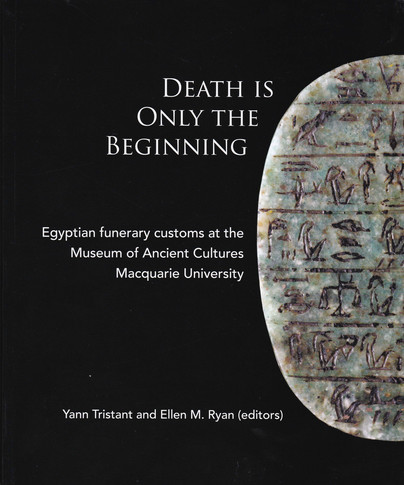
Format: Paperback
Pages: 318
ISBN: 9780856688522
Pub Date: 01 Dec 2017
Imprint: Australian Centre for Egyptology
Series: ACE Studies
Description:
Founded in 1974 as the Ancient History Teaching Collection (AHTC), the Museum of Ancient Cultures (MAC) is the archaeological museum of Macquarie University. The MAC main collection comprises c. 4700 genuine artefacts from Ancient Egypt, Greece, Cyprus, Rome, the Near East and the Indus Valley.
The Egyptian collection is widely regarded as one of the most important in Australia. This is the first catalogue of the collection detailing 72 Ancient Egyptian artefacts associated with funerary customs, from the Predynastic to the Coptic period. Divided into two parts, the catalogue aims to explore Ancient Egyptian funerary culture through an illustration of the MAC collection. Part One provides a series of articles on aspects of Ancient Egyptian funerary beliefs and practices. Part Two comprises the catalogue of artefacts, divided into four sections: pottery, funerary equipment, funerary texts, and religion and magic. In addition to high resolution photographs, each object receives detailed discussion of its composition and its significance to the study of Ancient Egypt more broadly. This catalogue will be an indispensable aid to students, researchers, and the general public interested in Ancient Egypt.
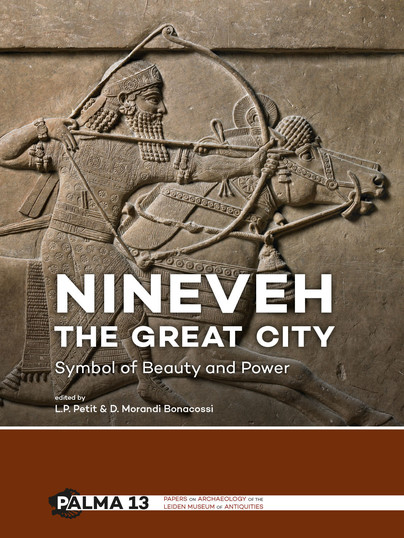

Pages: 330
ISBN: 9789088904974
Pub Date: 15 Nov 2017
Imprint: Sidestone Press
Series: Papers on Archaeology of the Leiden Museum of Antiquities
Illustrations: 110fc / 140bw
Pages: 330
ISBN: 9789088904967
Pub Date: 15 Nov 2017
Imprint: Sidestone Press
Series: Papers on Archaeology of the Leiden Museum of Antiquities
Illustrations: 110fc / 140bw
Description:
‘Well, as for Nineveh, skipper, it was wiped out long ago. There’s not a trace of it left, and one can’t even guess where it was’ (Lucian, 2nd century AD). Nineveh, the once-flourishing capital of the Assyrian Empire, has fascinated writers, travellers and historians alike since its complete annihilation by allied forces in 612 BC.
It was said to have been a great and populous city with 90-km walls, stunning palaces and colossal statues of pure gold. Since 1842 archaeologists have been investigating the ruins of Nineveh, which are located on the eastern banks of the river Tigris, near the modern Iraqi city of Mosul. The hundreds of thousands of objects that have been collected tell an intriguing story of life and death in a remarkable Mesopotamian city. The edited volume Nineveh, the Great City contains more than 65 articles by international specialists, providing the reader with a detailed and thorough study of the site of Nineveh. It describes the history of the city, the excavations and the dispersed material culture that can today be appreciated in more than 100 museums and institutes around the world. Special attention is paid to the endangered heritage of Nineveh, which recently faced destruction for the second time in its history. This lavishly illustrated volume is intended to appeal to readers interested in culture and heritage, as well as to students and professional academics.
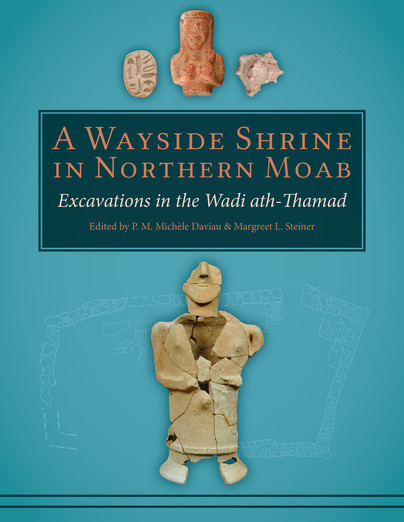
Format: Hardback
Pages: 272
ISBN: 9781785707087
Pub Date: 15 Sep 2017
Illustrations: b/w
Description:
Major recent excavations have shed much light on the complexity of Iron Age society and religion in southern Palestine, a region where both Judeans and Edomites lived. However, it is not clear whether the religious practices attested at these sites were a reflection of localised customs or were common rituals for peoples of Cisjordan and we do not know their extent. An isolated shrine site at Wadi ath-Thamad Site WT-13 in northern Moab which contained numerous finds of Iron Age figurines and statues has been the subject of detailed excavation.
The rich harvest of figurines, ceramic statues, beads, miniature ceramic vessels, architectural models, faunal remains and shells and fossils constitutes the evidence for repeated cultic activities. Although dating to the Iron Age at the time of the consolidation of the kingdom of Moab, there is insufficient evidence at present to determine the full range of cultic practices and deities venerated by the peoples of the lands within ancient Moab and by those visitors to the shrine. The links between WT-13 and the surrounding town sites is only now coming to light with excavation at Atarus and Khirbat al-Mudayna, as well as at the Ammonite site of Tall Damiyah in the Jordan Valley, where a comparable shrine has recently been uncovered. WT-13 clearly serves as a link between the Jordan Valley and the Negev, adding to our knowledge of local and foreign influences in the region during the Iron Age.
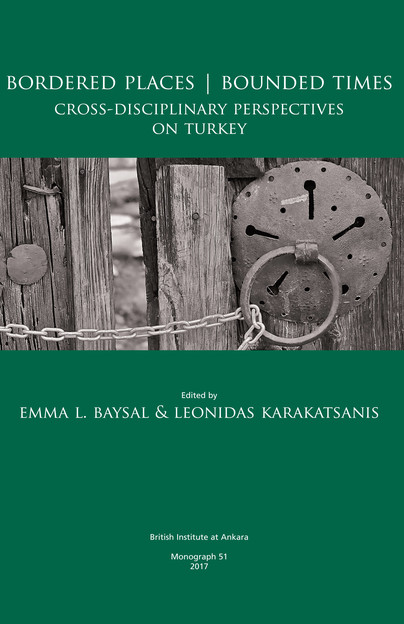
Format: Hardback
Pages: 224
ISBN: 9781898249382
Pub Date: 31 Aug 2017
Imprint: British Institute at Ankara
Series: British Institute at Ankara Monograph
Description:
Building on similarities and exploring differences in the way scholars undertake their research, this volume presents crossdisciplinary communication on the study of borders, frontiers and boundaries through time, with a focus on Turkey. Standing at the dividing/connecting line between Europe and Asia, Turkey emerges as a place carrying a rich history of multiple layers of borders that have been drawn, shifted or unmade from the remote past until today: from Palaeolithic hunter-gatherers to the period of early states in the Bronze Age, from the poleis of classical antiquity to the period of the empires defined by the Roman expansion and Byzantine rule, from the imprints of the Ottoman state’s expanded frontiers to contemporary Turkey’s national borders. Amidst proliferating interdisciplinary collaborations for the study of borders between social anthropology, geography, political science and history, this book aims to contribute to a nascent but growing direction in border studies by including archaeology as a collocutor and using Turkey as a case study.
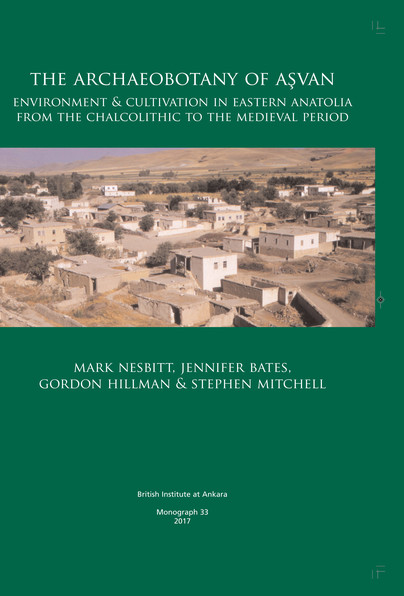
Format: Hardback
Pages: 244
ISBN: 9781898249177
Pub Date: 31 Aug 2017
Imprint: British Institute at Ankara
Series: British Institute at Ankara Monograph
Description:
This volume contains the final publication of the archaeobotanical remains recovered from four sites at the village of Aşvan in eastern Turkey, which were excavated between 1968 and 1973 as part of the archaeological rescue project in the Keban Dam region. An extensive programme of archaeobotanical research involved detailed study of the modern flora, the observation and recording of pre-mechanised agricultural practices and large-scale recovery of ancient botanical samples by water sieving. The report traces the evolution of cultivation in the region from the Chalcolithic to the Medieval period, charting the dominance of emmer and hulled barley in the Chalcolithic period, the emergence of free-threshing wheats in the Early Bronze Age and the introduction of irrigated summer crops, especially millet, by the Hellenistic period.
Detailed attention is also given to the assemblage of weed seeds as proxy evidence for environmental conditions and climate change from around 4000 BC to the present day.

Format: Paperback
Pages: 350
ISBN: 9781785706004
Pub Date: 30 Jun 2017
Series: Current Research in Egyptology
Illustrations: b/w
Description:
This volume reflects the most recent state of research on ancient Egypt presented and discussed at the international conference Current Research in Egyptology XVII, May 2016. Nine papers are arranged in chronological order covering the wide time span from the Predynastic till the Greco-Roman Period, with the remaining five considering more general thematic, theoretical, and cross-cultural topics. Papers re-examine the archives from early excavations of Predynastic tombs in the light of modern research; discuss various types of object from different periods; consider the roles of travelling artists, regional artistic schools styles, and the mobility of ancient high-skilled craftsmen.
Thematic, theoretical, and cross-cultural papers consider the relation of gods, cosmic sacredness, and fertility beliefs; take a comparative approach to cultural identity extracted from narrative poetry of Greek and Egyptian origin; the inclusion of Egyptian musical elements incorporated into Greek traditions and the analysis of artifacts from the Egyptian collection of Zagreb, illustrating the range of information that essentially unprovenanced objects may have for future research.
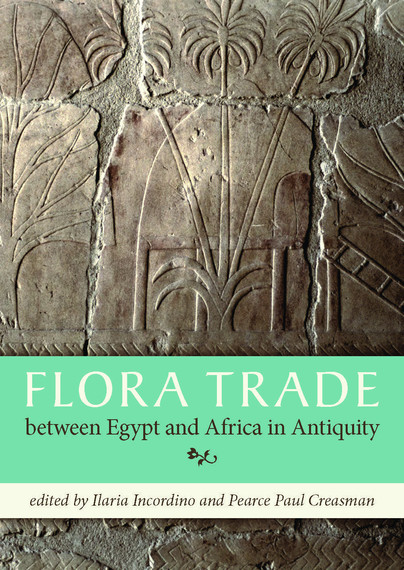
Format: Paperback
Pages: 112
ISBN: 9781785706363
Pub Date: 23 Jun 2017
Illustrations: b/w and colour
Description:
In recent decades, study of the ancient Egyptian natural world and its classification has adopted innovative approaches involving new technologies of analysis and a multidisciplinary general view. This collection of papers focuses on one particularly important aspect of foreign trade: the importation of aromatic products. Contributors present the results of the latest researches into the origin and meaning of foreign aromatic products imported in Egypt from the south (Nubia, Punt, Arabia, Horn of Africa) from the beginning of the Dynastic period.
The quest for aromata has been of a crucial importance in Egypt, since it was closely connected with economic, political, ideological, religious and mythic spheres. Through archaeological research, epigraphic analysis and iconographic investigations new evidence is explored supporting the most likely hypothesis about the sources of these raw materials. The study of related documents has revealed possible linguistic links between ancient Egyptian and other African ancient languages, and a strong link between aromata and the divine world through the creation of many Egyptian myths. The references to some specific aromatic products (ti-shepes, snetjer, antyw, hesayt) have been subject to careful lexicographic analysis, with special reference to Old Kingdom occurrences. Iconographic and field investigations documented here seek to better define the Egyptian way of representing the 'foreign' world and the value of its products in the spheres of Egyptian religiosity and rising Pharaonic ideology.
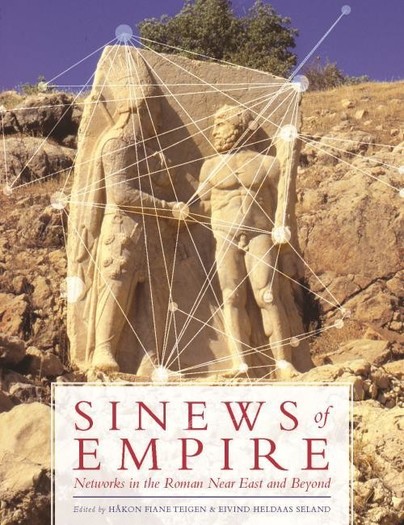
Format: Hardback
Pages: 240
ISBN: 9781785705960
Pub Date: 31 May 2017
Illustrations: b/w
Description:
A recent surge of interest in network approaches to the study of the ancient world has enabled scholars of the Roman Empire to move beyond traditional narratives of domination, resistance, integration and fragmentation. This relational turn has not only offers tools to identify, map, visualize and, in some cases, even quantify interaction based on a variety of ancient source material, but also provides a terminology to deal with the everyday ties of power, trade, and ideology that operated within, below, and beyond the superstructure of imperial rule. Thirteen contributions employ a range of quantitative, qualitative and descriptive network approaches in order to provide new perspectives on trade, communication, administration, technology, religion and municipal life in the Roman Near East and adjacent regions.
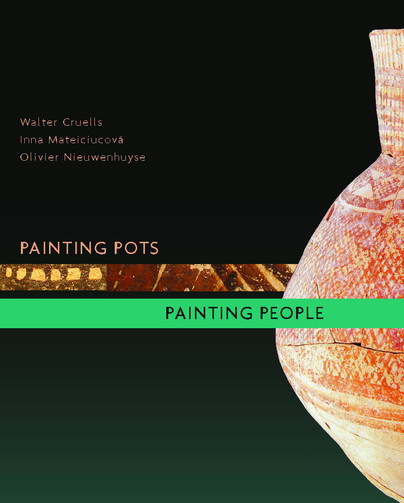
Format: Hardback
Pages: 272
ISBN: 9781785704390
Pub Date: 31 Mar 2017
Illustrations: b/w and colour
Description:
Archaeologists have recently made tremendous advances in understanding the early ceramic traditions of the prehistoric Near East. Over the past decade there has been a huge increase in research focusing on various aspects of ceramic production, its origins and evolution, distribution and consumption in the Late Neolithic (ca. 7000–5000 cal.
BC). Fieldwork brings new and exciting finds every year while laboratory studies change our perspectives regarding ceramic technology. Near Eastern ceramic specialists actively engage with, and contribute to, current trends in theoretical archaeology. For the first time, the 19 papers presented here bring together specialists discussing Neolithic ceramics from the Near East in the broadest sense. There is a general focus on decorated pottery traditions. What raw materials and ceramic technologies did Late Neolithic peoples employ? How did they paint their designs? How may we analyze decorated ceramics to explore social networks and identities? What did these decorated pottery traditions mean socially? Essential reading to Near Eastern prehistorians, these collected papers provide new insights for anyone interested in the development of early pottery traditions and the social significance of ceramics in Neolithic societies.
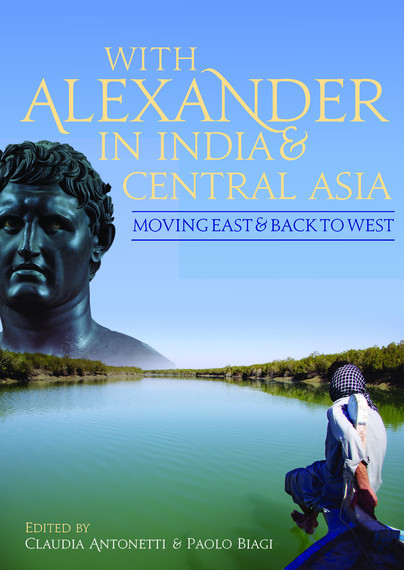
Format: Paperback
Pages: 304
ISBN: 9781785705847
Pub Date: 29 Mar 2017
Illustrations: b/w and colour
Description:
Alexander conquered most parts of the Western World, but there is a great deal of controversy over his invasion of India, the least known of his campaigns. In BC 327 Alexander came to India, and tried to cross the Jhelum river for the invasion, but was then confronted by King Porus who ruled an area in what is now the Punjab. According to Indian history he was stopped by Porus at his entry into the country, but most of the world still believes that Alexander won the battle.
Fearing the prospect of facing other large armies and exhausted by years of campaigning, Alexander's army mutinied at the Hyphasis River, refusing to march farther east. This river thus marks the easternmost extent of Alexander's conquests. Twelve papers in this volume examine aspects of Alexander’s Indian campaign, the relationship between him and his generals, the potential to use Indian sources, and evidence for the influence of policies of Alexander in neighbouring areas such as Iran and Russia.

Format: Hardback
Pages: 324
ISBN: 9781785706530
Pub Date: 27 Mar 2017
Series: Levant Supplementary Series
Description:
In this volume the principal focus is on the presence/absence of the city walls on the east side of the city from the Iron Age onwards. The evidence for major walls and their structure from Iron Age II to the Byzantine periods in Sites S.II and R.
II is described and substantial revisions suggested, as inter alia no evidence for the tenth century/Solomonic date in Site S.II as suggested by E. Mazar was uncovered. The strategic reasons for the location of the northern boundary of the earlier town is discussed in relation to evidence from Kenyon’s Site H. There is only sparse evidence for the PostExilic period in both areas. Parts of plastered basement rooms survived the destruction of AD 70. For the Roman period more evidence of the presence of the Roman army in the city is collated, including a possible watch tower, rare fragments of terra cottas and of fine imported South Gaulish pottery. Additionally John Hayes presents the catalogue of all the Late Roman fine wares from all remaining unpublished sites excavated by the Joint Expedition. Site S.II adds a little to the picture of the busy and extensive Byzantine city; and Site R.I provides a glimpse of extramural activities in the eighth/ninth centuries AD. A major contribution to the study of Ayyubid ceramics is provided by an assemblage from a large dump of the period. The analysis of iron working debris from Site L (the Armenian Garden) by Gethin and a reconsideration of the use of that area in Ayyubid and Mamluk times illustrates historical data, with ongoing activity in the late Ottoman period illustrated from Site S.II. The finds of the Ayyubid period were especially interesting for the insight provided into the lives of the inhabitants of the city.

Format: Paperback
Pages: 184
ISBN: 9781785705922
Pub Date: 21 Mar 2017
Illustrations: b/w
Description:
For almost 500 years (247 BCE–224 CE), the Arsacid kings of Parthia ruled over a vast multi-cultural empire, which encompassed much of central Asia and the Near East. The inhabitants of this empire included a complex patchwork of Hellenized Greek-speaking elites, Iranian nobility, and semi-nomadic Asian tribesman, all of whom had their own competing cultural and economic interests. Ruling over such a diverse group of subjects required a strong military and careful diplomacy on the part of the Arsacids, who faced the added challenge of competing with the Roman empire for control of the Near East.
This collection of new papers examines the cross-cultural interactions among the Arsacids, Romans, and local elites from a variety of scholarly perspectives. Contributors include experts in the fields of ancient history, archaeology, classics, Near Eastern studies, and art history, all of whom participated in a multi-year panel at the annual conference of the American Schools of Oriental Research between 2012 and 2014. The seven chapters investigate different aspects of war, diplomacy, trade, and artistic production as mechanisms of cross-cultural communication and exchange in the Parthian empire. Arsacids, Romans, and Local Elites will prove significant for those interested in the legacy of Hellenistic and Achaemenid art and ideology in the Parthian empire, the sometimes under-appreciated role of diplomacy in creating and maintaining peace in the ancient Middle East, and the importance of local dynasts in kingdoms like Judaea, Osrhoene, and Hatra in shaping the geopolitical landscape of the Near East, alongside the imperial powerhouses of Rome and Parthia.
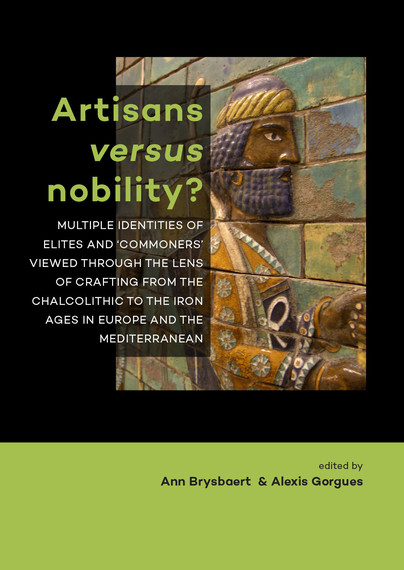
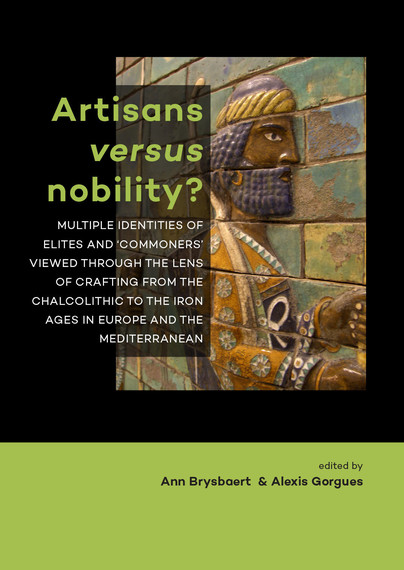
Pages: 222
ISBN: 9789088903977
Pub Date: 20 Mar 2017
Imprint: Sidestone Press
Illustrations: 80bw/20fc
Pages: 222
ISBN: 9789088903960
Pub Date: 20 Mar 2017
Imprint: Sidestone Press
Illustrations: 80bw/20fc
Description:
In prehistoric Europe hierarchic societies arose and developed technological systems and processes in the production of objects related to everyday use, on the one hand, and items of religious and symbolic character emulating prestige and luxury, on the other, while both types of objects may not always be clearly distinguishable. This volume deals with questions of how artisans and other social groups, involved in these productive processes and social practices, reacted to and interacted with the demands connected with elites identities formation, affirmation reconfirmation practices. Innovations and the development of new technologies designed to satisfy the needs of ostentatious behaviour and achieving prestige are key issues of this volume.
For example, how can we identify the consequences of such processes, how can we define the role(s) that the craftspeople played in such contexts, and are these always as clear-cut as usually portrayed? The book’s common aim is to investigate the economic, socio-political, as well as the technological contexts and backgrounds of the make-up of material culture and technologies in these periods. We examine which role(s) artisans may have played in status and identity formation processes, in rituals and in symbolic performances, in other words, in each aspect of life and death of selected Chalcolithic, Bronze and Iron Age populations in Europe. Many aspects of the social interaction patterns between the different groups of people in those periods have not been adequately discussed and investigated, especially the artisans’ important role(s). This volume aims to redress these imbalances by investigating how social groups interacted with each other, and how we may recognize such interactions in the material remains.

Format: Hardback
Pages: 160
ISBN: 9781785704819
Pub Date: 24 Feb 2017
Series: Ancient Egyptian Furniture
Illustrations: b/w
Description:
This revised second edition examines the common forms of furniture used in ancient Egypt, so much of which has been preserved by the dry Egyptian climate and has long been admired for the quality of its design and construction. The story begins with the earliest known pieces and ends with the spectacular discoveries from the 18th dynasty represented mainly by the magnificent furniture from the tomb of Tutankhamun. The insight which Dr Killen brings in the detailed explanations of the materials, techniques and designs of the master craftsmen of ancient Egypt, gives this book a special significance.
There is a catalogue of known pieces from museums around the world, classified by type – beds, stools, chairs and tables – with detailed analyses of the materials, tools and joinery. The splendid photographs and drawings illustrate each piece and technique.


















